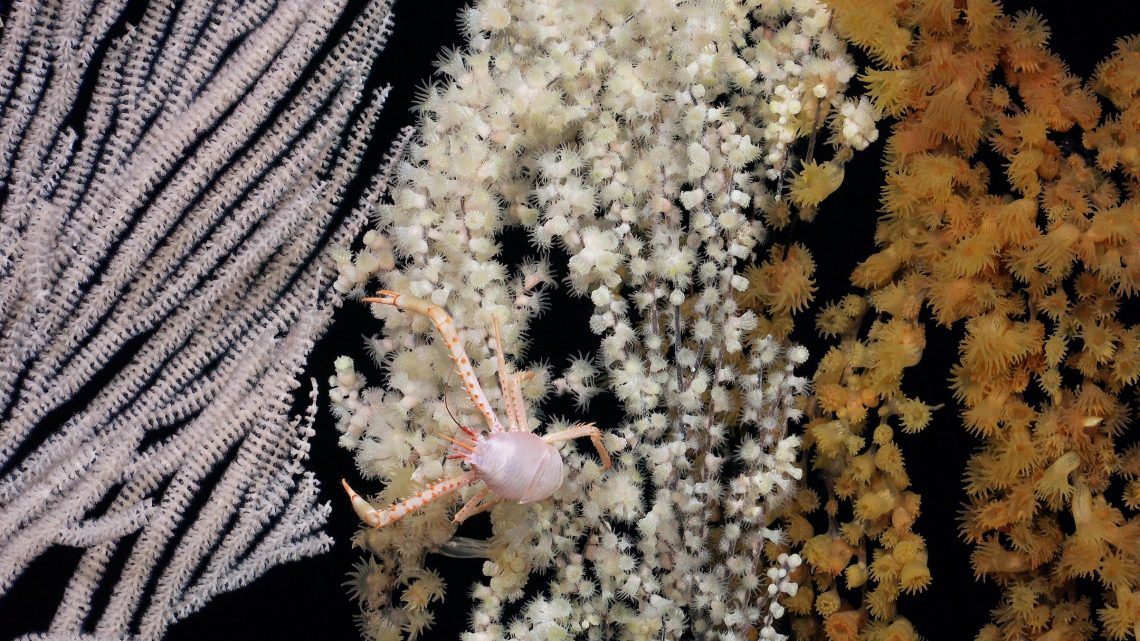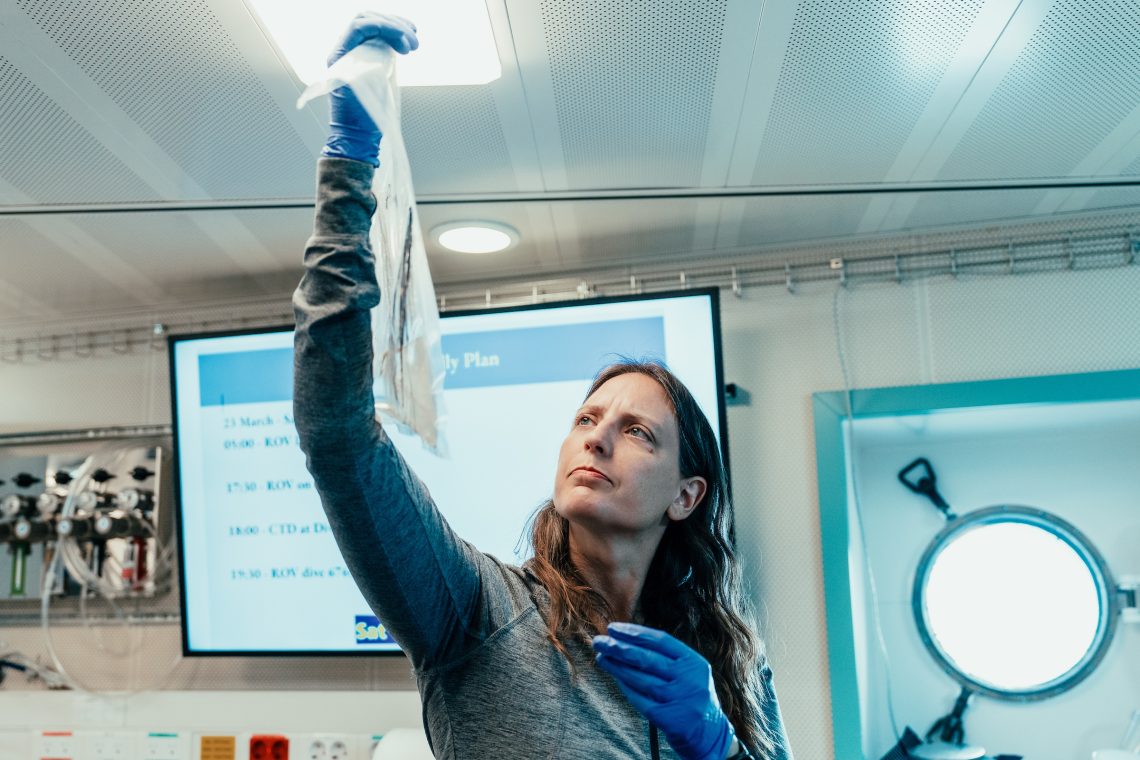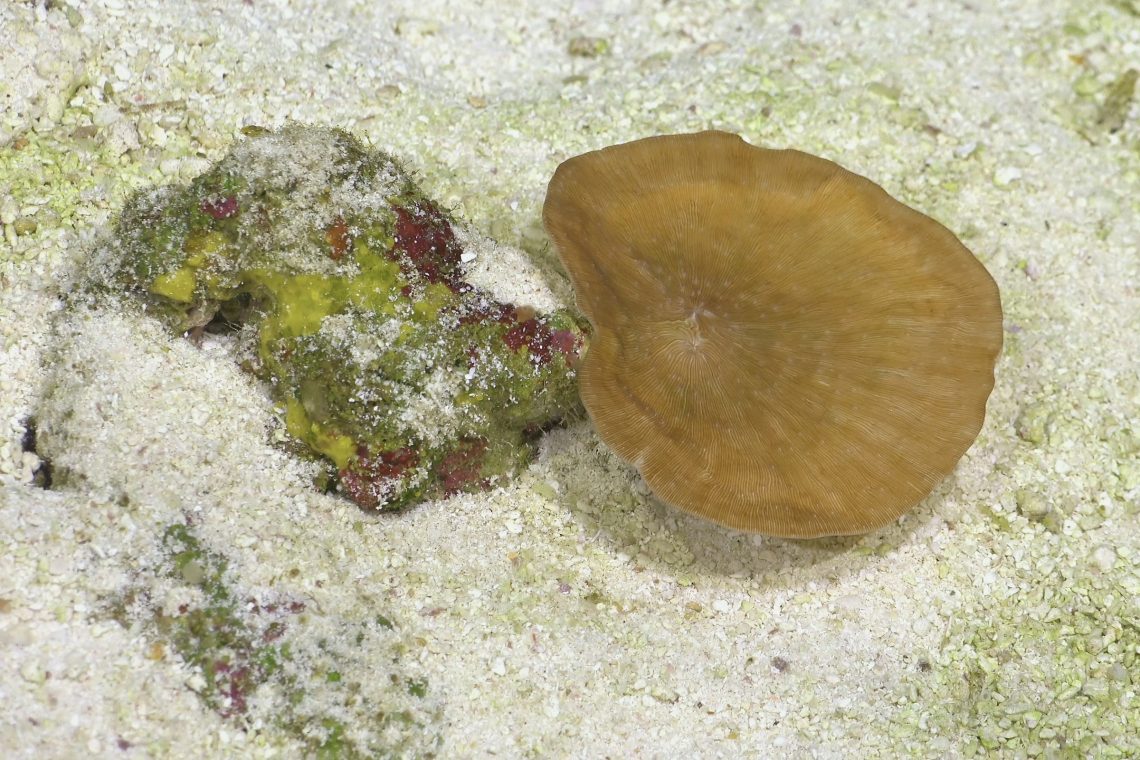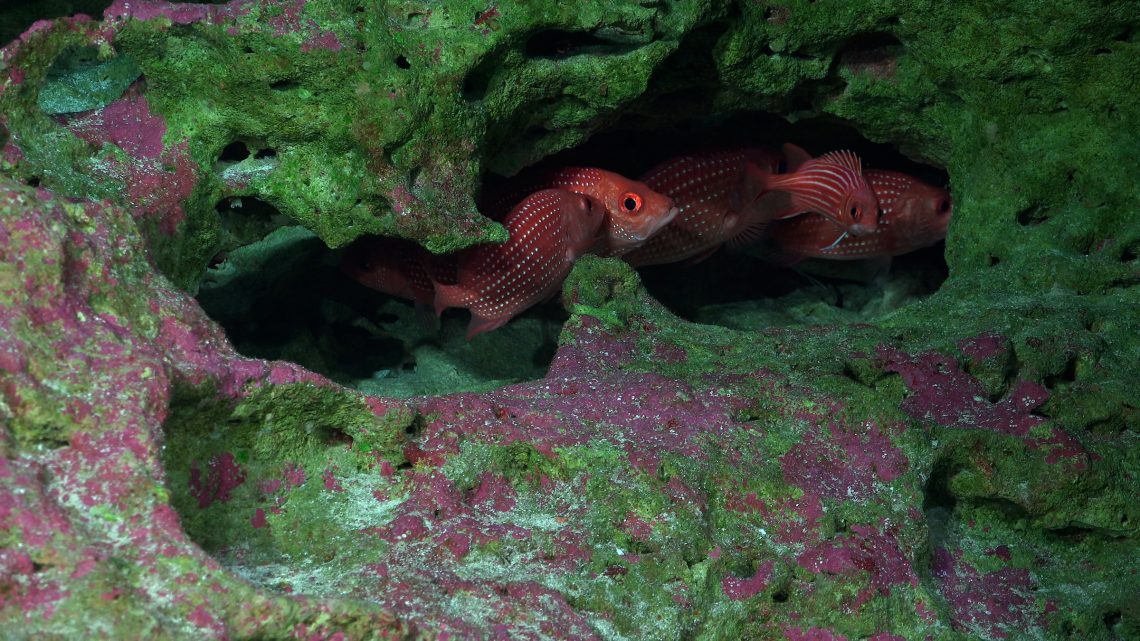Deep-sea coral reefs, sponge gardens, and the deepest photosynthesizing coral in the world found along the Salas y Gómez Ridge
Video and photos are available here
ANTOFAGASTA, Chile – An international team of scientists observed 160 species on the Salas y Gómez Ridge that had not yet been known to live in the region and suspect that at least 50 of these species are new to science. The observed species consists of squid, fish, corals, mollusks, sea stars, glass sponges, sea urchins, crabs, and squat lobsters, amongst others. Additionally, the team set a record for sighting the deepest-known photosynthesis-dependent animal in the world: a Leptoseris, commonly known as a wrinkle coral. The expedition follows a scientific research cruise in January, which primarily investigated the Nazca and Juan Fernandez Ridge seamounts and found 100 suspected new species.

The findings come after a team of scientists completed a 40-day research expedition across the Salas y Gómez Ridge to Rapa Nui, also known as Easter Island. The ridge lies off the coast of Chile and is a biologically rich region under consideration for a high-seas marine protected area designation. The research team, led by Drs. Erin E. Easton of the University of Texas Rio Grande Valley and Javier Sellanes of the Universidad Católica del Norte, closely examined 10 seamounts and two islands on the 2900-kilometer-long oceanic mountain range. They determined that the individual seamounts harbor distinct ecosystems like glass sponge gardens and deep coral reefs.
The information collected during this expedition will provide the scientific basis to inform the management of existing marine protected areas and potentially expand them, especially around the island of Rapa Nui. Koro Nui o te Vaikava, the Rapa Nui Sea Council, collaborated with the science team on the expedition. The council is the co-administrator of Chile’s most remote territorial seas and Rapa Nui’s marine protected area. They may assist in managing the Salas y Gómez high seas marine protected area, should it be established.
“The observation of distinct ecosystems on individual seamounts highlights the importance of protecting the entire ridge, not just a few seamounts,” said Chief Scientist Dr. Erin E Easton of the University of Texas Rio Grande Valley, “We hope the data collected from this expedition will help establish new marine protected areas, including on the high seas on the Salas y Gómez Ridge.”

The Salas y Gómez Ridge is one of several global locations under consideration for designation as a high seas marine protected area upon ratification of the UN High Seas Treaty. Parts of the ridge within Chile’s national jurisdiction are protected; however, much of the ridge lies in international waters. While many countries, including the United States, have signed the treaty, only Chile and Palau have ratified it. Once 60 nations ratify the treaty, countries can establish marine protected areas in international waters with sufficient scientific data.
The Salas y Gómez Ridge comprises over 110 seamounts and supports the migration of animals such as whales, sea turtles, swordfish, tuna, and sharks. During the expedition, 78,000 square kilometers were mapped, including six seamounts not yet documented in hydrographic surveys.

“The astonishing habitats and animal communities that we have unveiled during these two expeditions constitute a dramatic example of how little we know about this remote area,” said Dr. Javier Sellanes of the Universidad Católica del Norte, “These expeditions will help alert decision-makers about the ecological importance of the areas and contribute to strengthening protection strategies within and beyond jurisdictional waters.”
Much of the expedition occurred around Rapa Nui, near the ridge’s western end. The science team on the expedition explored waters adjacent to the island and spent a day making a cultural exchange visit. Four Rapa Nui community members, including a member of the Rapa Nui Sea Council, participated in the expedition alongside scientists from Chile, the United States, Italy, Spain, and the Netherlands.
“The importance of participating in an oceanographic scientific expedition for Rapa Nui lies in the opportunity to know and better understand the marine environment surrounding the island,” said Marcela Heys, observer and Rapa Nui Sea council member. “Natural resources, unknown marine species, and climate phenomena that directly affect the community can be discovered through research and exploration.”

This was the second expedition for Schmidt Ocean Institute’s R/V Falkor (too) in Chile. During the expedition, engineers tested new camera technologies, including a hyperspectral and stereo camera system developed by MBARI (Monterey Bay Aquarium Research Institute). The engineers hope to scale these low-cost technologies to better support biodiversity surveys on the seafloor.
“The international team on board Falkor (too) undertook a long voyage to shed light on this major, yet little mapped, underwater mountain range in the south Pacific and its diverse ecosystem,” said Schmidt Ocean Institute Executive Director Dr. Jyotika Virmani, “Schmidt Ocean Institute supports engineers developing novel technologies and the new cameras tested added immense detail and more easily showed the incredibly vibrant colors underwater and will, in future, aid us in better understanding marine life.”
About the Organizations
Schmidt Ocean Institute was established in 2009 by Eric and Wendy Schmidt to catalyze the discoveries needed to understand our ocean, sustain life, and ensure the health of our planet through the pursuit of impactful scientific research and intelligent observation, technological advancement, open sharing of information, and public engagement, all at the highest levels of international excellence. For more information, visit www.schmidtocean.org.
University of Texas Rio Grande Valley (UTRGV) was reimagined as a university for the entire Rio Grande Valley (Texas) in 2015. It is currently one of the largest Hispanic-Serving Institutions in the United States. Its mission is to transform the Rio Grande Valley, the Americas, and the world through an innovative and accessible educational environment that promotes student success, research, creative works, health and well-being, community engagement, sustainable development, and commercialization of university discoveries.
Universidad Católica del Norte is one of the 13 universities certified for excellence in Chile. The Faculty of Marine Sciences is located in the Guayacán Campus at Coquimbo and has a long history of research in marine sciences, hosting three undergraduate and five graduate programs https://www.ucn.cl/facultad-de-ciencias-del-mar/. ESMOI, its Center for Ecology and Sustainable Management of Oceanic Islands (https://sites.google.com/ucn.cl/esmoi-ing/home), bases its work on 4 fundamental axes: 1) frontier research, 2) training of young scientists, 3) formation of national and international collaboration networks, and 4) connection with the national and international sectors. Its goal is to generate the scientific basis necessary for a strategy of sustainable management and conservation of marine ecosystems associated with seamounts and oceanic islands from Chile and the Pacific, contributing to the UN Sustainable Development Goals.
The Koro Nui o te Vaikava promotes the sustainable management of the marine protected areas of the Rapa Nui ecoregion. The Koro Nui o te Vaikava, as co-administrator, has committed to being a key instrument in the management of the marine protected areas of Rapa Nui, with the aim of achieving sustainable use of marine resources. In this sense, the Koro Nui o te Vaikava works in close collaboration with different actors involved in the protection and conservation of marine ecosystems, promoting the implementation of measures and policies that guarantee the preservation of marine biodiversity and the sustainability of its own activities and of the Rapa Nui people around the marine environment. The Sea Council’s mission is crucial in finding a balance between the conservation of marine biodiversity and sustainable development, thus ensuring a healthy future for marine ecosystems and the communities that depend on them.
MBARI (Monterey Bay Aquarium Research Institute) is a non-profit oceanographic research center founded in 1987 by the late Silicon Valley innovator and philanthropist David Packard. Our mission is to advance marine science and technology to understand a changing ocean. Visit mbari.org to learn more.
# # # #
